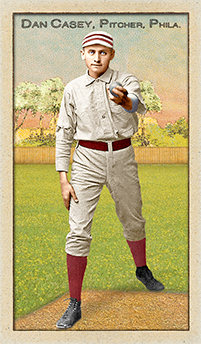
- Series: Beginnings: 1880's
- City: Indianapolis
- Team: Hoosiers (NL)
- League: National League
John Patrick Parnell Cahill (1865-1901) never did much damage to major league pitching but he hit well in the minors. Patsy’s brief stint in the big leagues included stops in Columbus, St. Louis and Indianapolis where the outfielder’s average was an anemic .205. A broken ankle with the Buckeyes ended his rookie season and may have been an omen that this gutty player belonged home in California. He had some great seasons out West, and the story gets retold that Ernest Thayer was so impressed by Patsy’s presence at the plate in a Stockton contest that he penned “Casey at the Bat” with him in mind. (The classic poem was published in 1888, the year before Cahill made it back to his home state). Patsy concluded his pro-ball in Texas with the Fort Worth Panthers in 1896.
- Cahill was versatile, even pitching several games and has been noted to have been part of the game’s first four-man rotation (for Columbus in ‘84 alongside the original “southpaw” Ed Morris)
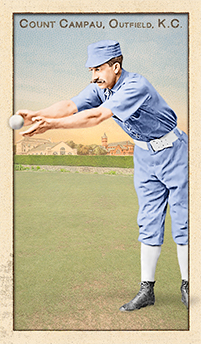
- Series: Beginnings: 1880's
- City: Kansas City
- Team: Blues (WA)
- League: Western Association
Charles Columbus Campau (1863-1938) may have been dubbed “The Count,” but he was the King of the Minors in the 19th century. No one matched his offensive output and he was prized especially for his defense. The scion of the French-Canadian founders of his native Detroit, Campau reigned in the society of the city and its ball fields. Educated at Notre Dame, he began playing there at an early age and soon came to dominate with his power and speed. He left Detroit with mentor Al Buckenberger to begin his pro career with Erie of the Interstate League in 1884. Thus began a two-decade tenure, mostly in the minors, that would take the Count to twenty different clubs including brief stints in the majors. His debut was back home with the Wolverines filling in for an injured Sam Thompson in ‘88. He stayed on with the newly constituted International League version of the Wolverines the following season and would have but one more turn in the big leagues, with the Browns in 1890 (save for two games with the Senators in ‘94). This would allow the hard-hitting Campau to claim a rare (unique?) distinction of leading the (minor league) International League and (major league) American Association in home runs in the same season. Charlie was known for his leadership skills and often served as on-field manager. Browns' owner Chris von der Ahe used him so in St. Louis that year and would call him “the best captain I have ever had.” Campau’s batting average could fluctuate, but his speed steadily improved to the point he was running foot races for prizes and was reputed to have never lost a match. The sketchy data of minor league stolen bases leaves a lot unknown but his feats were legendary. He swiped 100 bases in ‘87 and was renowned for a “home run” he hit by rounding the bases on a muffed pop-up in front of the plate.
- Campau continued in the minors through the 1905 season and umpired the following year. Never losing his love for speed, Charlie retired and went into the horse racing business and worked around the nation’s tracks in various capacities the rest of his life
- von der Ahe had sacked his prized manager for faithfully enforcing the owner’s own rules. The Count got a bit of revenge the next day, hitting an inside-the-park grand slam to the delight of St. Louis fans who rained down a deluge of cigars. Enough, Campau said, to open his own store
- Campau enjoys five known poses in the Old Judge canon
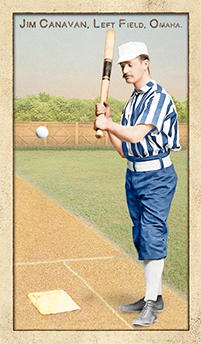
- Series: Beginnings: 1880's
- City: Omaha
- Team: Omahogs
- League: Western Association
James Edward Canavan (1866-1949) began in the major leagues during the 1891 season, playing more games for “King” Kelly’s Cincinnati “Killers” (aka “Porkers”) than any other team member. As the shortstop, Jim didn’t have a great average (.228) but he drove in the most runs, proving his clutch nature. Later that year, after the Killers were dissolved, Canavan and four others moved to Milwaukee. Canavan began and ended his pro-ball career in his native New England, beginning in New Hampshire and closing out his time in hometown New Bedford, playing and managing for the Whalers. After his rookie year, Jim played for Cap Anson’s Chicago Colts, then returned to the Queen City with the Reds before ending his big league tenure as a Brooklyn Bridegroom in 1897.
- Canavan piloted his New Haven Blues to the Connecticut State League pennant in 1902
- Captured here by the Old Judge photographers while with Omaha in 1889, Jim had a good year: 10 HRs, 93 Runs & 75 SBs in just 116 games
- Jim's uniform color on this card was changed in February, 2017 from red/white/black to blue/white/blue to reflect recent reliable research by Craig Brown & friends at Threads of Our Game. Five cards had been previously released featuring a red/white/black uniform.
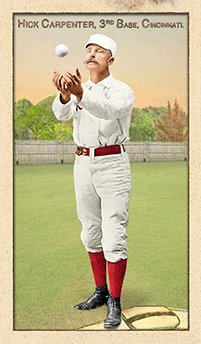
- Series: Beginnings: 1880's
- City: Cincinnati
- Team: Red Stockings (AA)
- League: American Association
Warren William Carpenter (1855-1937) was a solid-hitting, left-handed third baseman in the days when teams and leagues were figuring out modern baseball. “Old Hickory” began with the Syracuse Stars of Al Spalding’s League Alliance, a 28-team consortium that pioneered minor-league affiliation in 1877. He stayed the next year as the club joined the International League and made his MLB debut in ‘79 when the franchise became part of the National League. Two more NL clubs followed before Hick came into his own with the American Association’s Cincinnati Red Stockings from ‘82-89. His first season at Cincy was a great one as Carpenter led the league in hits & RBI with a .342 AVG. Over a twelve-year career Hick batted .259, collecting 1,200+ hits.
- Carpenter & Jimmy Macullar traveled to Cuba after the 1879 season, becoming the first North Americans to play in the Cuban League
- The lads’ Cuban League Colón club was so dominant that other teams refused to keep playing them
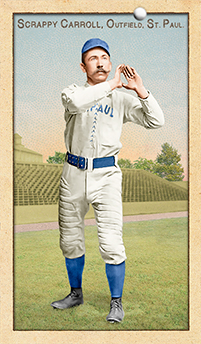
- Series: Beginnings: 1880's
- City: St. Paul
- Team: Apostles
- League: Western Association
John E. Carroll (1860-1942) began in MLB with the Union Association’s St. Paul White Caps in September 1884. The outfielder played in all nine games of the franchise’s only “season” going 3 for 31 with five errors. In ‘85, after stints with two minor-league clubs, Scrappy got a chance with the Buffalo Bisons of the NL. His .097 average fell when he went 3 for 41 in 13 games. Following time with the Utica Pent Ups, Carroll got his last chance in the majors with Cleveland’s Blues of the AA where he hit .199 in 57 games. His career average of .171 sent Scrappy permanently back to the minors. Old Judge misidentified one of his poses as being a Chicago Colts’ player, confusing him with Cliff Carroll.
- Carroll debuted in Cleveland on the city’s first Sunday game, August 3, 1887. He may or may not have innovated sunglasses, but he was noted for catching the attention of “the kranks” for donning “colored spectacles” one sunny day
- As so many before and since, Carroll had much more success in the minors, once even leading the Western League in home runs
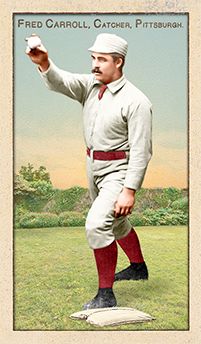
- Series: Beginnings: 1880's
- City: Pittsburgh
- Team: Alleghenys
- League: National League
Frederick Herbert Carroll (1864-1904) was born in Sacramento and, per Bill James, never really adjusted to life in the East. James touts Carroll as perhaps the finest “young” catcher, not only of his era, but until the arrival of Johnny Bench. Fred was nineteen when he started for the Columbus Buckeyes of the American Association. He moved on to spend seven more years in MLB for three Pittsburgh franchises in the AA, NL and Players' League. During this fairly brief tenure, Carroll twice hit over .300 and twice was among the league leaders in home runs. His career average of .284 justifies James' assessment of the rare hitter with power at catcher. Hall of Famer Buck Ewing set the standard for 19th century catchers, but Carroll was as solid as they come. Carroll had quite a year in 1886 with the Alleghenys. He set career marks in hits, doubles, triples and runs. And he also faced a club suspension for fighting teammate Otto Schomberg. Team owners, perhaps realizing how disliked Schomberg was, quickly ended Carroll's exile and lowered his fine to $50. The following season Fred became the first Pittsburgh player to hit for the cycle.
- In 1889 Carroll led the league in on-base percentage and slugging, said by the Encyclopedia of Baseball Catchers to be a record production for a catcher of that age (24)
- Carroll left the Steel City for his home state, playing for Oakland and SF in the minors
- Carroll's uniform color on this card was changed in February, 2017 from blue to red to reflect recent reliable research by Craig Brown & friends at Threads of Our Game. One card had been previously released featuring a blue uniform.
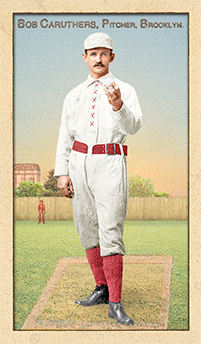
- Series: Beginnings: 1880's
- City: Brooklyn
- Team: Bridegrooms
- League: American Association
Robert Lee Caruthers (1864-1911) was a star pitcher, primarily for the Browns and Bridegrooms, leading his teams to five pennants in his 10-year career. Caruthers had the distinction of helping Brooklyn capture titles in consecutive seasons in two leagues: the AA in ’89 and the NL in ’90. One of the hardest working players of his day, Caruthers pitched in 340 games and played outfield in 366 as well as filling in occasionally at first and second. In 1886 while winning 30 games for St Louis, Caruthers had a league high .448 on base percentage, a pattern of plate and mound prowess that characterized this versatile dynamo.
- Caruthers won 40 for the Bridegrooms in ’89 and 23 the next year in the Senior Circuit
- Only Whitey Ford (barely) edged Caruthers in winning percentage for those with 200+ games
- No player who spent most of his career in the AA has made the Hall of Fame
- Caruthers' uniform color on this card was changed in January, 2017 from blue to red to reflect recent reliable research by Craig Brown & friends at Threads of Our Game. Nine cards had been previously released featuring a blue uniform.
- Series: Beginnings: 1880's
- City: Philadelphia
- Team: Quakers
- League: National League
Daniel Maurice Casey (1862-1943) was dubbed by Time “the Mudville Man” and helped inaugurate the Hall of Fame in 1939 with a stirring re-enactment of Casey at the Bat. Whether he was Ernest Thayer’s model or not, Casey was a fine pitcher for the Philadelphia Quakers, leading the NL in ERA in 1887. He pitched 7 years for 4 teams, won 96 games with two 20+ seasons.
- Became a candidate for THAT Casey by striking out, breaking Quakers fans’ hearts 8/21/87
- The week prior, Casey had won the game with his only career HR, inspiring the fans’ hopes
- In ’87 he won 28 of the 45 games he started, with a 2.86 ERA in 390 innings
- Series: Beginnings: 1880's
- City: St. Louis
- Team: Browns (AA)
- League: American Association
Elton P. Chamberlain (1867-1929) was a right-hander for 6 teams over 10 ML seasons, including at least one game he finished as a southpaw. A study in perseverance, the icy-calm Chamberlain doggedly refused to give in to Boston’s Bobby Lowe on May 30, 1894, eventually surrendering 4 HRs to a batter for the first time in history. Lowe added a single to keep Ice Box in the record books for most total bases to a batter in one game. In 1888-89 he went 25-11 and 32-15 for the Browns.
- Led the American Association with six shut-outs in 1890 for the Columbus Solons
- Completed 264 of his 301 career starts and ranks 64th all time in that statistic
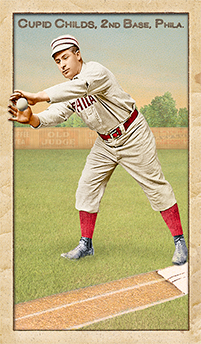
- Series: Beginnings: 1880's
- City: Philadelphia
- Team: Quakers
- League: National League
Clarence Algernon Childs (1867-1912) was not only a fine second-baseman, he was an excellent batsman with a knack for getting on base. He played 13 seasons in the majors for five clubs. His best years were the eight he spent with the Cleveland Spiders where he played alongside Cy Young, Jesse Burkett, Bobby Wallace, Buck Ewing, George Davis and John Clarkson. Never elected to the Hall of Fame, Cupid’s on-base percentage exceeds that of every second-baseman in Cooperstown but Rogers Hornsby and Eddie Collins and his lifetime .306 average is better than a dozen who made it in. The stocky Childs was dubbed “the dumpling” by a Grand Rapids reporter describing his tryout with Kalamazoo in 1888. Yet, the article said Cupid could cover more ground than most. His arrival in Cleveland resulted from a favorable ruling in a nationally publicized case when the Orioles tried to hold him to a contract ruled null. Childs fit in well with Patsy Tebeau’s “hooligans” through the 1890s.
- Ranks 24th all-time in OBP (.416), just behind Stan Musial
- Had a great eye at the plate, striking out only once every 26 at bats

- Series: Beginnings: 1880's
- City: Chicago
- Team: White Stockings
- League: National League
William H. Clarke (1865-1911) learned early why the major leaguers get the big bucks: he had uniformly outstanding success on the mound in the minors with an overall 1.81 ERA. Things were always tougher with the big clubs: an ERA of 4.16 and a journeyman record of 44-51 during seven seasons. Dad’s best year came with the Giants in 1895 where he won 18 with a 3.39 ERA. Things must have looked different when he came out of Lorain, OH to the Sandusky Suds in 1887 winning 21 with a rookie ERA of 1.13. Similar results followed in Des Moines and Omaha. Clarke even got to do a turn out west with the San Francisco Haverlys and a short stay with the Jacksonville (IL) Lunatics where it must have maddened him to go 3-3 despite a 0.87 ERA. Always a strong-willed character (the nickname reflected a grizzled visage), Dad sparred and stormed through a long up-and-down career.
- Per SABR, Dad’s innovative “system” of pitching “slants” influenced Big Train Johnson to perfect his own motion
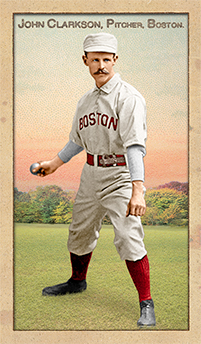
- Series: Beginnings: 1880's
- City: Boston
- Team: Beaneaters
- League: National League
- Hall: National Baseball Hall of Fame
John Gibson Clarkson (1861-1909) won 328 games, won the triple crown in 1889 and twice pitched more than 600 innings in a season. In 1885, John appeared in 70 games, threw 68 complete games, 623 innings, won 53, had an ERA of 1.85, a no-hitter, and won the pennant. Apparently having to hurl the sphere a mere fifty feet was a tonic to the arm. But unlike so many pitchers of his era, Clarkson didn’t flame out from such prodigious labor on the mound. From 1885-92 he AVERAGED 36 wins per season and would win 30+ an extraordinary six times. This great career began with the Worcester Ruby Legs in 1882, flowered with Cap Anson’s Sox in ‘84 and fully bloomed in Boston when John followed his ace catcher King Kelly to the Beaneaters in ‘88. League politics that culminated in the Players’ League revolt took a toll on Clarkson’s reputation and sundered his friendship with Kelly as the hurler remained loyal to the Nationals.
- Cleveland acquired John in 1892 allowing him to team with Cy Young. Chief Zimmer, who caught Young for a decade, proclaimed Clarkson the best he ever saw
- Elected to Hall of Fame: 1963
- Although the Old Judge series features seven known poses of John Clarkson (all in a Chicago White Stockings uniform), this image is taken from a cabinet photo produced by the Conly Studio in Boston.

- Series: Beginnings: 1880's
- City: Philadelphia
- Team: Quakers
- League: National League
John Clements (1864-1941) was known best for being a left-handed catcher and, by far, the most durable and enduring southpaw ever to play the position in the majors. Jack caught four times as many games (1,073) as any other port-sider in history and was the last to catch regularly in the major leagues. Jack played 17 seasons and is credited as the first receiver to wear a chest protector. His .394 BA in 1895 is highest ever at his position and he was among the top four in batting average three times. He was also the first big leaguer to catch 1,000 games. Clements’ power was such that, upon retirement, he was the all-time leader for catchers in single-season and career home runs. Jack came up with the Union Association’s Philadelphia Keystones in that league’s sole season, 1884. When the team folded in August, Jack became the backstop for the National League’s Quakers (Phillies) franchise for 14 seasons before playing out his MLB career with three other teams.
- Jack had trouble laying down the tools. In 1900, following his final year in the NL, he played for the only minor league squad of his long career, a dozen games with the Providence Clamdiggers. He hit .295
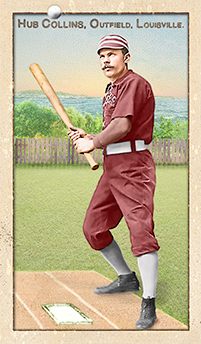
- Series: Beginnings: 1880's
- City: Louisville
- Team: Colonels
- League: American Association
Hubert B. Collins (1864-1892) was a good-hitting outfielder/second-baseman for two major league clubs from 1886-1892. He came up with the Louisville Colonels of the American Association and moved to the Brooklyn Bridegrooms late in the ‘88 season. Hub played out his career in Brooklyn in both their AA and NL franchises. He managed a fine .284 lifetime average in seven years. In 1890 during his team’s back-to-back title years, Collins led the league in runs scored. The young Louisville native had begun in pro ball with Columbus in the Southern League in ‘85 and came up to his hometown team the next year from Savannah.
- Brooklyn paid the Colonels $4500 for the young utility man in September 1888
- Hub suffered a head injury in a horrific collision with Tom Burns in July 1891. A passing locomotive drowned each others’ call for the short fly ball. He never recovered, succumbing to typhoid fever the next spring
- Hub's uniform color on this card was changed in January, 2017 from blue to maroon to reflect recent reliable research by Craig Brown & friends at Threads of Our Game. Four cards had been previously released featuring a blue uniform.
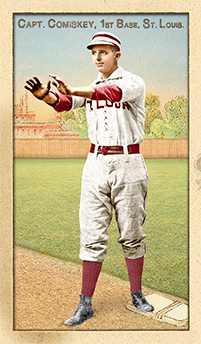
- Series: Beginnings: 1880's
- City: St. Louis
- Team: Browns (AA)
- League: American Association
- Hall: National Baseball Hall of Fame
Charles Albert Comiskey (1859-1931) rose from decent first-baseman to become one of the foremost managers and owners of baseball’s early decades. “The Old Roman’s” leadership skills emerged with his first team, the newly-minted St. Louis Browns whom he piloted to four pennants. He would go on to compile an outstanding 840-541 record. His .608 winning percentage is third-highest behind Joe McCarthy and Jim Mutrie. “Commy” parlayed his ownership of the Western Association’s Dubuque Rabbits into a franchise in the American League which he helped found in 1901. He built the White Sox stadium in 1910 which would bear his name for the next 81 years and presided for the next decade over one of the most talented and troubled teams in history. While many dismiss the charge that it was Comiskey’s penurious ways that “drove” his 1919 squad to infamy, there is no doubt he was a cheapskate of the first order. He underpaid, over-promised and reneged with abandon, epitomizing the arrogance of the reserve-clause era.
- Charles is credited with revolutionizing play at first-base, innovating play off the bag
- Owned the Chicago White Sox from 1901-1931, winning two World Series
- Elected to Hall of Fame: 1939

- Series: Beginnings: 1880's
- City: New York
- Team: Giants
- League: National League
- Hall: National Baseball Hall of Fame
Roger Connor (1857-1931) was the home run king of the 19th century, clouting 138 in his 18-year career. His record stood for 23 years after his retirement, until Babe Ruth surpassed him in 1921. Connor anchored first-base for five teams, winning pennants twice with the Giants. His flair for the dramatic was never more evident than when he struck the first-ever major league grand slam with his team down by three with two outs in the ninth. Born in Connecticut, Roger played for local clubs until joining the Troy Trojans in 1880. That NY hamlet witnessed five future Hall of Famers on their squad with Connor playing alongside Dan Brouthers, Buck Ewing, Tim Keefe and Mickey Welch. After moving to the Gothams, the 6’3” Connor inspired owner Jim Mutrie to proclaim the team “my giants!” and a new identity was born.
- Much more than a slugger, Connor won the NL batting title in 1885 and consistently hit .300+ while exhibiting remarkable speed for a big man (still fifth all-time in triples)
- Connor lived to see Ruth claim his HR title. It was thought at the time, however, that Connor had hit 131 HRS and Ruth's record was celebrated at 132. Writing for SABR in 1975, John tattersall discovered that Connor had actually hit 138 HRs.
- Jay Jaffe's JAWS system ranks Connor as the 5th greatest 1st baseman of all-time, just behind Cap Anson and just ahead of Jeff Bagwell
- Beloved by fans and the baseball press, he had a particularly strong advocate for the Hall in fellow legend, umpire Bill Klem
- Elected to Hall of Fame: 1976

- Series: Beginnings: 1880's
- City: Boston
- Team: Beaneaters
- League: National League
Richard Butler Conway (1865-1926) earned quite a reputation for toughness in his native Lowell, MA and the New England League. Although his reliance on his off-speed pitches signaled a short career in the majors (in an era when the heater dominated from fifty feet), Conway's overhand fastball clocked Bill McGunnigle, fracturing his skull and ending a playing career for the future National League manager. The reputation may have stemmed less from the beaning than the fact that it was the third straight high hard one that decked Mac at Brockton that summer of 1885.
Conway was signed to his first major league contract with the American Association's Baltimore Orioles in 1886 but was soon returned to the minors. He got a big break after pitching his Portland team to a win in Boston against the Blues who shared the South End Grounds with the Beaneaters, bringing him to the NL's attention. Boston hired him for the '87 campaign. The Globe faulted his reliance on his curve and “using his arm entirely....He fails to get any speed on the ball and much strength is wasted.” Nevertheless, Dick's debut showed promise and the same paper lauded his effective control and all-around play. After going 5-1, the league caught on to him and he finished 9-15.
- Plagued with a sore arm, Conway ended his two-plus years MLB tenure with a 15-24 record and 4.78 ERA
- Dick was part of a “brother battery” with older sibling Bill with the '86 Orioles, among only sixteen such pairings in the majors
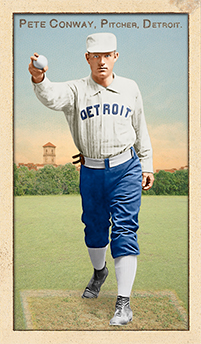
- Series: Beginnings: 1880's
- City: Detroit
- Team: Wolverines
- League: National League
Peter J. Conway (1866-1903) was a tough right-hander who played in tough luck with his early major-league clubs. Both the Buffalo Bisons and Kansas City Cowboys struggled to seventh-place finishes and failed to support their youngster during the 1885-86 seasons. He came into his own with a much better Detroit Wolverine squad for three years, helping the club win the pennant and post-season tourney in ‘87. Pete’s best year was in ‘88, going 30-14. The Wolverine franchise and Conway’s arm gave out. Pete went to the Alleghenys but got into only three games. Pressures were building that would culminate in the Players’ League “revolt” and the cavalier treatment Conway received in Pittsburgh was widely seen as all-too-typical. Pete tried unsuccessfully to play for Ward’s Wonders in 1890 but the arm was gone.
- In 1891 Conway was hired as the first head coach of the other Wolverines: those of the University of Michigan
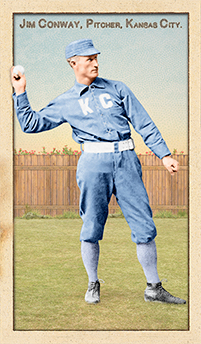
- Series: Beginnings: 1880's
- City: Kansas City
- Team: Blues (WA)
- League: Western Association
James P. Conway (1858-1912) pitched briefly in 1884 and ‘85 for the Brooklyn Atlantics and Philadelphia Athletics of the American Association. He was 3-9 for the Brooklyn and 0-1 for the A’s before returning to the minors, primarily in the Western and Southern leagues. Jim came back up with the Kansas City Blues in 1889 and had a fine season, winning 19 as the ace of a struggling team that finished 7th in the AA. The year before, Jim’s kid brother Pete had won 30 games for the Detroit Wolverines but quickly faded from the game along with Jim who’s arm gave out after that one stellar year. Jim managed to return to the mound after a year’s layoff but went only 8-12 for two minor league clubs in 1891-92.
- It has been speculated that Conway’s demise as a major-league pitcher had more to do with attitude than physical limitations. He was nicknamed “Dark Days” to signify a sour disposition
- Jim was a teammate of Hall-of-Famer Billy Hamilton who stole 111 bases in 1889

- Series: Beginnings: 1880's
- City: Louisville
- Team: Colonels
- League: American Association
Paul Cook (1863-1905) got into three games at catcher for Harry Wright’s struggling Philadelphia Quakers at the end of the 1884 season. He returned to the minors before getting picked up by the Louisville Colonels where he stayed four years before jumping to Ward’s Wonders for the Players’ League season of 1890. Cook finished up the following year with three teams, back in Kentucky, then the Lincoln Rustlers and, finally, the St. Louis Browns. During his five years with the Colonels, Cook batted a mere .219 with no power.
- In his early days, Cook played for Muskegon in the Northwestern League, the Toledo Avengers of the Western League, and the Washington Nationals of the Eastern League
- Paul played in D.C. for manager Mike Scanlon who would lead the club in ‘86 as they joined the National League
- Cook's uniform color on this card was changed in January, 2017 from blue to maroon to reflect recent reliable research by Craig Brown & friends at Threads of Our Game. One card had been previously released featuring a blue uniform.

- Series: Beginnings: 1880's
- City: Indianapolis
- Team: Hoosiers (NL)
- League: National League
Lawrence J. Corcoran (1859-1891) was a shining star who left a short trail through the baseball heavens before flaming out in ill-health and an exhausted right arm. He could even use the left one and did pitch ambidextrously on at least one occasion. Few players of any era could have better fulfilled media prophecy: on Sept 13, 1879 the NY Clipper predicted that with good catching support “it would be difficult to get a base hit from his pitching.” Only two others would exceed Larry’s rookie 43 win total. By 1884 Corcoran would hurl his third no-hitter. He was the first to accomplish the feat and it wasn’t matched until Koufax many decades later. For five glorious years with Anson’s White Stockings, Corcoran was phenomenal: 170 wins, 246 CG and the no-nos.
- Unsurprisingly, the arm wearied. His body, afflicted by Bright’s disease, failed too, at age 32
- Per his SABR biographer: “Corcoran possessed all the attributes of greatness except durability”
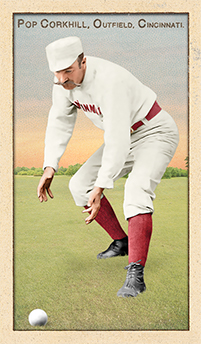
- Series: Beginnings: 1880's
- City: Cincinnati
- Team: Red Stockings (AA)
- League: American Association
John Stewart Corkhill (1858-1921) was an excellent fielder who found steady work in the outfields of the Red Stockings and Bridegrooms from 1883-90. Pop was still in demand and played out his career in Philadelphia and Pittsburgh before a beanball served up by Ed Crane prompted the veteran to hang ‘em up in 1892. Corkhill led the league in fielding several times, twice with his first club in Cincinnati and twice in Brooklyn where he played for pennant-winners in ‘89 (NL) and ‘90 (AA). A clutch hitter, Pop drove in 97/97/93 during a fine stretch from 1886-88. Proving his versatility, Corkhill made relief appearances in five seasons. He recorded two saves in an era not known for bullpen assistance.
- Corkhill was acquired by Brooklyn late in the ‘88 season along with the notoriously voluble Oyster Burns as owner Charles Byrne assembled a powerful squad
- Pop’s NY Times obituary noted that he had established a record with Cincinnati, playing three consecutive years without dropping a fly ball
- Corkhill passed away at home following surgery. It is unknown whether this was related to his career-ending injury
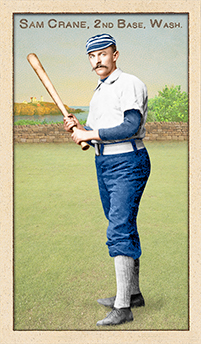
- Series: Beginnings: 1880's
- City: Washington, D.C.
- Team: Nationals
- League: National League
Samuel Newhall Crane (1854-1925) played second base for eight major league teams in three leagues from 1880-90. Sam lacked power (three career HRs, .203 average) despite a sturdy 6’, 190-lb frame. He was only a little more adept stealing bases (25 over the decade). Somehow, the practice of thievery on the bases carried over into Sam’s private life and his mediocre tenure in the big leagues ended ignominiously when he was accused of stealing a local merchant’s cash and wife. Such a checkered past was no hindrance to a longer career as a sportswriter. True to his tarnished image, Sam was mired in controversy as a scribe, getting himself barred from the Polo Grounds after attacking Giants’ owner Andrew Freedman in print. Whatever unpaid debts Crane left on the field or in the press box, he more than made up for by becoming an early and ardent promoter of creating a “memorial” to past stars of the game in Cooperstown, NY. His and others' efforts eventually led to the establishment of the National Baseball Hall of Fame in Cooperstown in 1939.
- Crane’s ouster amid the “circus” atmosphere surrounding the Giants made him a brief cause celebre among journalists aghast that one of their own should be censored
- Crane's uniform color on this card was changed in February, 2017 from black to blue to reflect recent reliable research by Craig Brown & friends at Threads of Our Game. Two cards had been previously released featuring a black uniform.

- Series: Beginnings: 1880's
- City: Chicago
- Team: Maroons
- League: Western Association
John T. (or F.) Crogan is another of those tantalizing “mystery men” of the Old Judge card era. Many of their subjects were photographed in anticipation of a major league career that never happened. In this case, Jack was posed for five images in the OJ 1888 series. He wears the uniform of the Chicago Maroons of the Western Association as depicted in the Miller/Gonsowski/Masson definitive OJ text with middle initial T. whereas Baseball-Reference.com has him with F. Prior to his brief time with the Maroons (21 games, .188 BA) Jack was with Wheeling in ’87, apparently his first year in the minors. He went on to play in the Texas and Tri-State Leagues before finishing up with Davenport of the Illinois-Iowa League in 1891. The rest of this would-be big leaguer’s exploits are lost to history.
- The Miller compilation shows a possible alternate surname spelling of Croghan
- The only batting pose available shows Jack in a left-handed stance
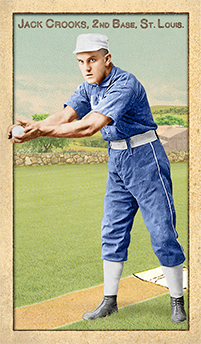
- Series: Beginnings: 1880's
- City: St. Louis
- Team: Whites (WA)
- League: Western Association
Charles John Crooks (1865-1918) became the first player in organized ball known to have hit four home runs in a game, accomplishing the feat for the Omaha Omahogs in 1889. The whole Western League had struggled to stay afloat that year and the team’s sale of Crooks to the American Association’s Columbus Colts that summer enabled them to make a profit (Omaha got $1750 for their outfielder and netted $1000 for the year). The four homers proved his strength but it was Crooks’ uncanny ability to draw walks that made him most valuable. He remains among a handful of players to record more bases on balls than games in a season, ranking him with the likes of Ted Williams, the Mick and the Babe. With a lifetime OBP of .408 and a BA of .237, Jack is in the top-ten highest ratio of the two.
- Despite Jack’s sabermetric value, the 1890 Colts were his only winning team in an 8-year career
- Jack cut short his baseball career after finding success as a cigar salesman







